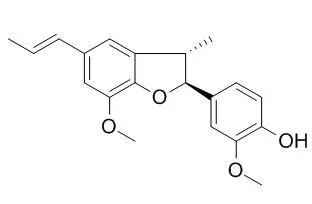| Br J Pharmacol. 2005 Nov;146(5):752-9. |
| Meso-dihydroguaiaretic acid and licarin A of Machilus thunbergii protect against glutamate-induced toxicity in primary cultures of a rat cortical cells.[Pubmed: 16151440] |
We previously reported that four lignans isolated from the bark of Machilus thunbergii Sieb. et Zucc. (Lauraceae) protected primary cultures of rat cortical neurons from neurotoxicity induced by glutamate.
METHODS AND RESULTS:
2 Among the lignans, meso-dihydroguaiarectic acid (MDGA) and Licarin A significantly attenuated glutamate-induced neurotoxicity when added prior to or right after the excitotoxic glutamate challenge. 3 The neuroprotective activities of two lignans appeared to be more effective in protecting neurons against neurotoxicity induced by NMDA than that induced by kainic acid. 4 MDGA and Licarin A diminished the calcium influx that routinely accompanies with the glutamate-induced neurotoxicity, and inhibited the subsequent overproduction of cellular nitric oxide and peroxide to the level of control cells. They also preserved cellular activities of antioxidative enzymes such as superoxide dismutase, glutathione peroxidase and glutathione reductase reduced in the glutamate-injured neuronal cells.
CONCLUSIONS:
5 Thus, our results suggest that MDGA and Licarin A significantly protect primary cultured neuronal cells against glutamate-induced oxidative stress, via antioxidative activities. |
| Exp Parasitol. 2013 Oct;135(2):307-13. |
| Neolignan Licarin A presents effect against Leishmania (Leishmania) major associated with immunomodulation in vitro.[Pubmed: 23891943] |
Leishmaniasis' treatment is based mostly on pentavalent antimonials or amphotericin B long-term administration, expensive drugs associated with severe side effects. Considering these aforementioned, the search for alternative effective and safe leishmaniasis treatments is a necessity.
METHODS AND RESULTS:
This work evaluated a neolignan, Licarin A anti-leishmanial activity chemically synthesized by our study group. It was observed that Licarin A effectively inhibited Leishmania (Leishmania) major promastigotes (IC₅₀ of 9.59 ± 0.94 μg/mL) growth, by inducing in these parasites genomic DNA fragmentation in a typical death pattern by apoptosis. Additionally, the neolignan proved to be even more active against intracellular amastigotes of the parasite (EC₅₀ of 4.71 ± 0.29 μg/mL), and significantly more effective than meglumine antimoniate (EC₅₀ of 216.2 ± 76.7 μg/mL) used as reference drug. The antiamastigote activity is associated with an immunomodulatory activity, since treatment with Licarin A of the infected macrophages induced a decrease in the interleukin (IL)-6 and IL-10 production.
CONCLUSIONS:
This study demonstrates for the first time the antileishmanial activity of Licarin A and suggests that the compound may be a promising in the development of a new leishmanicidal agent. |
| Phytochemistry. 2011 Aug;72(11-12):1424-30. |
| Schistosomicidal and trypanocidal structure-activity relationships for (±)-licarin A and its (-)- and (+)-enantiomers.[Pubmed: 21570099] |
(±)-Licarin A (1) was obtained by oxidative coupling, and its enantiomers, (-)-Licarin A (2) and (+)-Licarin A (3), were resolved by chiral HPLC.
METHODS AND RESULTS:
Schistosomicidal and trypanocidal activities of these compounds were evaluated in vitro against Schistosoma mansoni adult worms and trypomastigote forms of Trypanosoma cruzi. The racemic mixture (1) displayed significant schistosomicidal activity with an LC₅₀ value of 53.57 μM and moderate trypanocidal activity with an IC₅₀ value of 127.17 μM. On the other hand, the (-)-enantiomer (2), displaying a LC₅₀ value of 91.71 μM, was more active against S. mansoni than the (+)-enantiomer (3), which did not show activity. For the trypanocidal assay, enantiomer 2 showed more significant activity (IC₅₀ of 23.46 μM) than enantiomer 3, which showed an IC₅₀ value of 87.73 μM.
CONCLUSIONS:
Therefore, these results suggest that (±)-Licarin A (1) and (-)-Licarin A (2) are promising compounds that could be used for the development of schistosomicidal and trypanocidal agents. |






 Cell. 2018 Jan 11;172(1-2):249-261.e12. doi: 10.1016/j.cell.2017.12.019.IF=36.216(2019)
Cell. 2018 Jan 11;172(1-2):249-261.e12. doi: 10.1016/j.cell.2017.12.019.IF=36.216(2019) Cell Metab. 2020 Mar 3;31(3):534-548.e5. doi: 10.1016/j.cmet.2020.01.002.IF=22.415(2019)
Cell Metab. 2020 Mar 3;31(3):534-548.e5. doi: 10.1016/j.cmet.2020.01.002.IF=22.415(2019) Mol Cell. 2017 Nov 16;68(4):673-685.e6. doi: 10.1016/j.molcel.2017.10.022.IF=14.548(2019)
Mol Cell. 2017 Nov 16;68(4):673-685.e6. doi: 10.1016/j.molcel.2017.10.022.IF=14.548(2019)